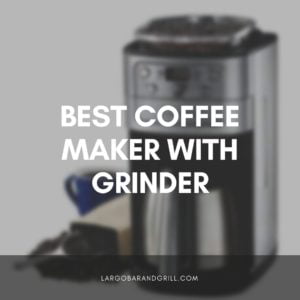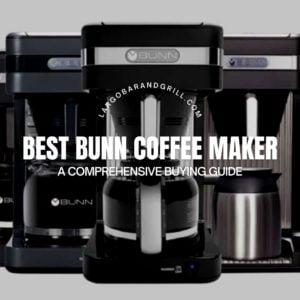Disclaimer: There are affiliate links in this post. At no cost to you, I get commissions for purchases made through links in this post.
1. Use Fresh, Pure Water
Good coffee starts with good water. Use only filtered water if using tap water. I prefer to use bottles of Deer Park spring water, as the taste of my coffee is very important. Bad tasting water makes for bad tasting coffee. Filtering tap water helps, but doesn’t get everything out.
And, do not use distilled water. You need some mineral content to properly extract the good stuff from your coffee. The absence of some minerals can lead to very sharp and bitter tastes. Besides the minerals are good for your body too!
2. Quality of your coffee
Some roast levels perform better in different brew methods. Lighter roasts can taste aggressively bright in immersion brewers and some pour over methods don’t really showcase the caramelized sweetness in darker roasts. Of course, brew ratios can address some of these issues.
3. How much coffee should I use? How much water?
Here’s the coffee/water ratio:
The most common “coffee making” mistake is using too little coffee. Water flowing through the coffee grounds extracts flavors, therefore too little coffee will result in weak coffee. The rule of thumb is to use 2 tablespoons of ground coffee for every 6 ounces of water.
Caveats:
The traditional “coffee measure” measures precisely 2 tablespoons
some coffeemakers come with 1 tablespoon scoops
Remember that one standard measuring “cup” = 8 fluid ounces so ¾ of a “cup” = 6 fluid ounces
4. Try the coffeehouse ratio:
Using better machines and higher-quality beans makes for richer, more intensive flavor. But good coffeehouses use more coffee when brewing, too: 2 tablespoons of coffee per 6 ounces of water.
5. Grind to Perfection
Do you grind your own beans?
If you are a casual coffee drinker then grinding your own coffee beans may sound like an extravagance. Well, you are probably right – but grinding your our coffee will result in better tasting coffee. Grinding the coffee allows more contact between water and beans – ideally resulting in more flavor.
How you grind your coffee greatly influences the resulting brew. Grind your coffee too fine and you will get bitter coffee, grind it too coarse and you’ll get watery coffee.
You may have realized already, that I use and recomend a coffeemaker that grinds the beans right before brewing, you can’t beat that for freshness!
6. All About Grinds:
Coarse Grind: best for a French press.
Medium Grind: best for auto-drip machines.
Fine Grind: best for espresso or cone filters
7. Grinds and extraction:
Most people find that when 20% of soluble solids are extracted from the coffee grounds, the brew has the best flavors. Too much extraction (too fine grind, too long brew time, too hot water, too much ground coffee) and the brew tastes bitter.
On the other hand, under-extraction results in a thin, weak, sour cup. Simply using more coffee grounds doesn’t correct under-extraction. It is a good idea to weigh your coffee or use an SCAA coffee scoop or a measuring device that you know will hold 10 grams of coffee. It is also a good idea, at least initially, to weigh or measure your water as well.
8. Coffee particle size
A finer grind means more surface area of the bean is exposed to the water. For a brew method that uses a longer dwell time such as French Press, a coarser grind is necessary. An even grind of any size is ideal, follow the directions on your grinder, it may take some experimentation to find the best grind for your brew method.
9. What type of grinder?
If you use a blade-type grinder, while grinding hold the lid down with one hand and shake it up and down. This will yield a more even grind and reduce the amount of powdery grounds which can make coffee bitter. Better yet, invest in a good quality burr-type grinder, available at better kitchenware stores. Gaining in popularity are the new coffee makers that grind your beans automatically then brews your coffee. You’ll taste the difference.
The blade vs. burr debate. Blade grinders chop beans into bits, yielding grounds of varying sizes, leading to an inconsistent brew. Burr grinders, little millstones, grind beans to a uniform size between two plates. And you can adjust grind size according to your own brewing method. Coffee aficionados like the more costly burrs for that reason.
10. Best Way to Serve Coffee
Everyone has their preference but I have found the best way to enjoy exotic coffee, if you do not enjoy it black, is by adding half & half and raw sugar.
As I may have mentioned earlier, I’m now using coconut sugar, it doesn’t spike blood sugar levels like sugar does, has a taste flavor and is stuffed full of nutrients
.
Even if you are watching your calories, I would suggest staying away from Splenda. Sweet & Low and Equal, there seems to be health risks from these. Plus they are saying that artificial sweetners increase your sugar craving and could cause you to put on weight!
11. Gil’s favorite coffee flavoring tips
If you like flavored coffee, avoid the pre-flavored and packaged beans. These beans are sprayed with oils that are almost impossible to completely clean from your grinder and coffee machine. And after several different flavors have mixed in your equipment, your coffee will have some weird tastes to it.You don’t want that do you? Besides, although the sprays that they use smell good, they are not good at flavoring.
Buy coffee syrups. They are made from high quality ingredients. They are easy to use. They taste and smell great. They are consistent and you can control the amount of flavoring and sweetness. I personally try to avoid those flavorings that contain corn syrup and alcohol.
Right now I’m enjoing a cup of coffee that I added an amazing natural bourbon vanilla flavoring to!
12. Consider these flavoring additions to your coffee:
• A pinch of salt to coffee grounds will help combat acidic coffee.
• Spice up coffee with a pinch of cinnamon, nutmeg, or allspice added to the ground coffee. Citrus zest will also add zing to boring coffee.
13. Enjoy iced coffee? Try this:
Instead of putting ice cubes in your coffee and watering down, brew a fresh pot of coffee, let it cool to about room temperature, then pour the coffee into some ice trays. Freeze, and now you have frozen coffee cubes! Now, when the cubes melt, your coffee will not become weaker and weaker.
14. Water Temperature
The ideal water temperature is 195-205 f, since water is a better solvent at near-boiling temperature. This is why it is always better to brew a full batch on an auto-drip machine, since they are built to get a full batch of water up to the proper temperature.
15. Store Beans Properly
Always store your premium coffee in an airtight opaque container such as Tupperware, away from heat, moisture and light. If you don’t have an airtight container the next best thing is to seal it in an airtight zip lock bag.
To maintain your coffee’s freshness and flavor proper coffee storage is essential. Whether storing ground coffee or coffee beans, certain principles need to be followed in order to ensure that coffee maintains its peak freshness and taste.
Not all coffee should go in the freezer. In fact, if you’re going to actually use the coffee right away, you don’t want it going straight from the icebox to under steaming water.
Find a coffee seller that roasts their own beans, or at least offers honest details on when their stuff was roasted, then divide your stash into weekly amounts. Keep the current week’s stash in an airtight container at room temperature, or as some would advise, sealed in the refrigerator, and keep the other weeks’ portions in the freezer.
Personally, I am against storing your coffee in the fridge or freezer, moisture and fluctuating temperature can be harmful to your coffee.
I use Earth Pride whole bean coffee which comes in quality bags that protect the freshness of the coffee. When I open a bag, a place the beans in air tight plastic containers with screw on lids, and keep at room temperature.
16. General coffee storage tips from coffee experts:
Number one, remember that air is the enemy of coffee. Coffee begins to lose its flavor six hours after roasting. The more coffee comes into contact with air, the more flavor it loses.
So, for the sake of the coffee’s freshness and flavor, these rules need to be followed:
- Don’t store coffee beans in glass canisters. These let air in.
- Don’t freeze your daily coffee supply. The moisture will cause the flavor to deteriorate.
- Don’t keep your coffee next to an oven. Heat will also cause coffee to lose flavor.
- Don’t keep coffee in the refrigerator.
- Refrigerators have many odors in them, and coffee absorbs all these odors. For this reason, used coffee grounds make great odor fighters in the fridge.
- Store coffee in air-tight containers.
- Keep your coffee in a dark, cool place.
- Buy only enough coffee that will be used in one to two weeks. After this time, the exposure to air will take most of the flavor from the coffee.
- If the coffee is not used within two weeks, then it should be put in the freezer.
- Once coffee is taken out of the freezer, it should not be put back in. The contact with moisture will cause it to lose its flavor.
- Remember, glass carafes and other containers should never be left on the burner for more than 10 minutes. An airtight thermos-type container is the preferred hot storage container and will keep hot coffee fresh considerably longer.
- Coffee in its pot, sitting on the burner, will scald the coffee really quickly. In fact, the taste changes so much that most reputable coffee houses will pour the coffee out after it has been on the burner for only 20 minutes!
- If you are the type who takes a while to drink your coffee in the morning, get a coffee maker that will brew into a thermal pot or carafe. Since constant heat is not applied, the coffee will not cook and will taste good for an hour or more
17. Why Whole Beans are Better than Ground Coffee
Whole beans maintain the flavor and richness of coffee longer. Coffee begins to deteriorate from the moment coffee is ground. Premium coffee from gourmet coffee retailers only ship coffee that is freshly roasted.
18. Bagged Coffee- How’s your bag?
Is the bag good? Freshly roasted beans off-gas carbon dioxide. Valve-sealed bags let the gas escape in transit. Cans or vacuum-sealed bags contain beans that have been aired out.
19. How much caffeine is in your coffee?
Starbucks co-founder Jerry Baldwin explains in a blog post the myths and realities of caffeine levels. I’m sharing a portion of it with you:
“Robusta” beans pack twice as much caffeine as “Arabica,” “dark roast” means effectively nothing in terms of caffeine, and drip coffee can actually pack more caffeine than espresso, depending on the beans and amounts used.
20. Ever considered using a French Press?
A French press consists of a beaker/glass pot with a plunger/filter/metal screen. Course ground coffee is placed in the beaker – then “just off the boil” water is poured directly onto the grounds. The coffee brews for 4 to 6 minutes, then the plunger is pushed down – separating the “coffee” from the “coffee grounds.”
The resulting brew is very strong and has a “full body” for lots of flavor.
Coffee comes out better when you use a French press, even a cheap one. Here’s why:
One of the primary benefits of making coffee in a French press over a standard drip pot is that more of the coffee oils end up in your cup instead of in the machine’s filter. More oils means better taste!
Did you relize that a carefully cleaned French press can also double as an excellent pot for loose leaf tea! Great idea, right?
21. Keep your automatic drip coffee maker clean
A good rule of thumb is: if you smell an odor from your equipment, clean it. If you can’t remember the last time you cleaned your brewer, clean it.
Over time, drip coffee makers accumulate “impurities” (from hard water and coffee oils). These impurities result in longer brewing times and bitter coffee. Fortunately cleaning a drip coffee maker is simple and easy.
- Fill coffee pot with a mixture consisting of 1 part vinegar to 2 parts water
- Place a filter in the coffee maker and run mixture through
- Allow machine to cool completely
- mix another pot of vinegar/water – run again – cool again
- rinse pot with warm water then run clean water through – cool again
- Run clean water through (if you can taste vinegar in the water – repeat rinse again)
And please remember:
- Don’t use soapy water to clean a dirty coffee pot (unless you like the taste of soap in your coffee) – instead put some ice cubes, water, and table salt into the pot – swirl around, then rinse.
Related Posts
Best French Press Coffee Maker To Buy
Disclaimer: There are affiliate links in this post. At no...
Read MoreBest Coffee Maker With Grinder
Disclaimer: There are affiliate links in this post. At no...
Read MoreBest Bunn Coffee Maker: A Comprehensive Buying Guide
Disclaimer: There are affiliate links in this post. At no...
Read MoreWhy Trust Us
You will find what you are looking for at Largo Bar and Grill. From classic to luxury brands, you'll find both. We will help you to select appliances that fit your needs, budget and lifestyle. Whether you want to stop by to learn more — or plan to make a major purchase — we’ll treat you like family and assist you every step of the way. Shop with us today to receive friendly and experienced help along the way.



